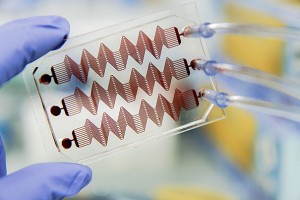Microfluidics Device Close to Predict Clots in Real Time

Researchers from the Wyss Institute for Biologically Inspired Engineering at Harvard University have developed a device that allows to predict if a blood sample will have a tendency to coagulate and form clots. The new technology could benefit patients with abnormal platelet function. The study has been published in the journal Nature Communications.
Haemostasis is the set of mechanisms that allow an organism to keep blood in the blood vessels. In the event of vascular damage, our bodies are capable of maintaining haemostasis by coagulation, transforming liquid blood into a gel. The mechanism involves the activation of platelets that adhere and aggregate, and the deposition of fibrin. Some people suffer from coagulation disorders like hemorrhage -when bleeding can’t be stopped- or thrombosis -when clots obstruct the blood vessels. Assessment of haemostasis is very important for these patients, but current technology doesn’t monitor properly the haemodynamic forces that influence platelet function. Group leader Donald Ingber hypothesized that haemostasis should be controlled by testing blood in the same conditions it experiences inside the body. Ingber and his team designed a microfluidic device that has tiny conducts that simulate blood vessels.
A microfluidic device that can be connected to the vascular network
The device can imitate pathological conditions -derived from diseases or treatments- in blood vessels that cause them to narrow and are potentially fatal for patients. These changes in small arterioles can alter fluid mechanics and eventually cause blood to form clots. The device can analize a blood sample extracted from a patient, althought it can potentially be connected to the patient’s vascular network. Pressure sensors send information to the processing unit, and proprietary data-analysis software measures haemostasis in real time.
The research team already tested the device in humans, and was able to detect abnormal platelet function in patients with a rare disease that causes bleeding. They also tested the device in large animals, connecting it directly to their blood vessels, and could predict precise clotting times.
Source: Harvard gazette


